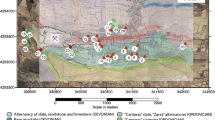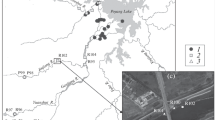Abstract
To evaluate the mercury sources and its transportation mechanism from a global hotspot region (the Ganga Alluvial Plain, northern India), two sets of time-series samples of shallow groundwater (n = 31) and river water (n = 31) were collected in alternate days, from the Behta River Basin, in July and August 2019. The estimation of total dissolved mercury was performed by using the Flow Injection Atomic Absorption Spectroscopy-Mercury Hydride System. The mercury concentrations ranged high (> 1400 ng/L), in the three orders of magnitude, emphasizing the importance of mercury transportation, through the unconfined alluvial aquifer system, linked with the monsoon precipitation. In July, the accumulative intensity of monsoon precipitation favored the increasing mercury concentrations in the river water, as well as, in the groundwater. The infiltration of mercury contaminated water is the prominent hydrological process accountable for the peaked mercury concentration (above the World Health Organization’s drinking water standard of 1000 ng/L) in the river basin. In August, about 67% of the collected samples reported base-level mercury concentrations. Temporal variations of mercury concentration in the groundwater and the river water showed significantly higher values in July, than in August. These results illustrate the importance of the interaction between the monsoon precipitation, and anthropogenic mercury, in the river basin, for the riverine and groundwater mercury transportation as the fundamental hydraulic control. The present study underscores the significance of monsoon precipitation on the groundwater transportation of global mercury cycling by the Ganga River.



source: CPCB, 2002]

source of drinking water


source and Fig. 2(a) for the sample location

source and Fig. 2(a) for the sample location
Similar content being viewed by others
References
Agarwal R, Kumar R, Behari JR (2007) Mercury and lead content in fish species from the river Gomti, Lucknow, India, as biomarkers of contamination. Bull Environ Contam Toxicol 78:118–122. https://doi.org/10.1007/s00128-007-9035-8
Amos HM, Jacob DJ, Kocman D, Horowithz HM, Zhang Y, Dutkiewicz S, Horwat M, Corbitt ES, Krabbenhoft DP, Sunderland EM (2014) Global biogeochemical implications of mercury discharges from river and sediment burial. Environ Sci Technol 48:9514–9522. https://doi.org/10.1021/es502134t
Balogh SJ, Swain EB, Nollet H (2006) Elevated methylmercury concentrations and loadings during flooding in Minnesota rivers. Sci Total Environ 368(1):138–148. https://doi.org/10.1016/j.scitotenv.2005.09.045
Barringer JL, Szabo Z (2006) Overview of investigations into mercury in groundwater, soils and septage, new jersey coastal plain. Water Air Soil Pollut 175:193–221. https://doi.org/10.1007/s11270-006-9139-1
CPCB (2002) A report on state of environment Lucknow. Central Pollution Control Board, Ministry of Environment and Forest, Government of India
Das TB, Choudhury A, Senapati RN (2015) Mercury emissions from coal fired power plants of India. Int J Energy Sustain and Environ Eng 2(1):21–24
Dwivedi S, Mishra S, Tripathi RD (2018) Ganga water pollution: a potential health threat to inhabitants of Ganga basin. Environ Int 117:327–338. https://doi.org/10.1016/j.envint.2018.05.015
Hammerschmidt CR, Fitzgerald WF, Lamborg CH, Balcom PH, Tseng CM (2006) Biogeochemical cycling of Methylmercury in Lakes and Tundra watersheds of Arctic Alaska. Burial Environ Sci Technol 40:1204–1211. https://doi.org/10.1021/es051322b
Huang J, Kang S, Wang S, Wang L, Wang K, Zhang G, Tripathee L (2013) Wet deposition of Mercury at Lhasa, the capital city of Tibet. Sci Total Environ 447:123–132. https://doi.org/10.1016/j.scitotenv.2013.01.003
Kisku GS, Yadav S, Sharma RK, Negi MPS (2012) Potential environmental pollution hazards by Coal based power plant at Jhansi (UP) India. Environ Earth Sci 67:2109–2120. https://doi.org/10.1007/s/12665-012-1651-x
Kowalski A, Siepak M, Boszke L (2007) Mercury contamination of surface and ground waters of Poznan. Poland Polish J Environ Stud 16(1):67–74
Krabbenhoft DP, Babiarz CL (1992) The role of groundwater transport in aquatic mercury cycling. Water Resour Res 28(12):3119–3128
Loewen MD, Sharma S, Tomy G, Wang F, Bullockn P, Wania F (2005) Persistent organic pollutants and mercury in the Himalaya. Aquat Ecosyst Health Manag 8(3):223–233. https://doi.org/10.1080/14634980500220924
Louis VL, Rudd JWM, Kelly CA, Beaty KG, Bloom NS, Flett RJ (1994) Importance of wetlands as sources of methyl mercury to boreal forest ecosystems. Can J Fish Aquat Sci 51:1065–1076
Mehrotra S (2004) Micro level studies on groundwater management on depletion and pollution in Lucknow city, U. P., (2001–2002), Central Ground Water Board. Ministry of Water Resources, Government of India
Mishra PK, Rai A, Rai SC (2020) Land use and land cover change detection using geospatial techniques in the Sikkim Himalaya, India. Egypt J Remote Sensing Space Sci 23(2):133–143. https://doi.org/10.1016/j.ejrs.2019.02.001
Morel FMM, Kraepiel AML, Amyot M (1998) The chemical cycling and bioaccumulation of mercury. Annu Rev Ecol Systemat 29:543–566
Mukherjee AB, Bhattacharya P, Sarkar A, Zevenhoven R (2009) Mercury emissions from industrial sources in India and its effects in the environment. Mercury Fate Transp Glob Atmos. https://doi.org/10.1007/978-0-387-93958-2_4
Pal M, Ghosh S, Mukhopadhyay M, Ghosh M (2012) Methyl mercury in fish–a case study on various samples collected from Ganges river at West Bengal. Environ Monit Assess 184:3407–3414. https://doi.org/10.1007/s10661-011-2193-5
Rai VK, Raman NS, Choudhary SK (2013) Mercury in thermal power plants—a case study. Int J Pure App Biosci 1(2):31–37
Raju A, Singh A, Srivastava N, Singh S, Jigyasu DK, Singh M (2019) Mapping human health risk by geostatistical method: a case study of mercury in drinking groundwater resource of the central ganga alluvial plain, northern India. Environ Monit Assess 191(Suppl 2):298. https://doi.org/10.1007/s10661-019-7427-y
Rice KM, Walker EM, Wu M, Gillet C, Blough ER (2014) Environmental mercury and its toxic effects. J Prev Med Public Health 47:74–83. https://doi.org/10.3961/jpmph.2014.47.2.74
Sehgal M, Garg A, Suresh R, Dagar P (2011) Heavy metal contamination in the Delhi segment of Yamuna basin. Environ Monit Assess 184:3407–3414. https://doi.org/10.1007/s10661-011-2131-9
Singh IB (1996) Geological evolution of Ganga Plain-an overview. J Palaeonto Soc India 41:99–137
Singh KP, Singh VK, Malik A, Sharma N, Murthy RC, Kumar R (2007) Hydrochemistry of wet atmospheric precipitation over an urban area in Northern Indo-Gangetic Plains. Environ Monit Assess 131(1–3):237–254. https://doi.org/10.1007/s10661-006-9472-6
Singh M, Kumar S, Kumar B, Singh S, Singh IB (2013) Investigation on the hydrodynamics of Ganga Alluvial Plain using environmental isotopes: a case study of the Gomati River Basin, northern India. Hydrogeol J 21:687–700. https://doi.org/10.1007/s10040-013-0958-3
Sinha RK, Sinha SK, Kedia DK, Kumari A, Rani N, Sharma G, Prasad K (2007) A holistic study on mercury pollution in the Ganga river system at Varanasi. India Curr Sci 92(9):1223–1227
Thakur A (2007) Morphology and Basin Characteristics of Gomati River, the Ganga Plain, India, Unpublished Ph. D. thesis, University of Lucknow
Tripathee L, Kang S, Sharma CM, Kumari A, Rani N, Sharma G, Prasad K (2016) Preliminary health risk assessment of potentially toxic metals in surface water of the Himalayan Rivers. Nepal Bull Environ Contam Toxicol 97:855–862. https://doi.org/10.1007/s00128-016-1945-x
UNEP (2013) Global Mercury Assessment 2013: Sources, Emissions, Releases and Environmental Transport. United Nations Environment Programme Chemicals Branch, Geneva, Switzerland. 44
Wang S, Zhang L, Li G, Wu Y, Hao J, Pirrone N et al (2010) Mercury emission and speciation of coal-fired power plants in China. Atmos Chem Phys 10:1183–1192
Wang XP, Yao TD, Wang PL, Yang W, Tian LD (2008) The recent deposition of persistent organic pollutants and mercury to the Dasuopu glacier, Mt Xixiabangma, central Himalayas. Sci Total Environ 394:134–143. https://doi.org/10.1016/j.scitotenv.2008.02.016
WHO (2004) World Health Organization, Guidelines for Drinking-water Quality, Geneva, 3nd edition.www.who.int/water_sanitation_health/dwq/GDWQ2004web.pdf
Acknowledgements
We greatly acknowledge Prof. Indra Bir Singh (University of Lucknow, Lucknow) for his motivation and Dr. Anjali Singh (Mohanlal Sukhadia University, Udaipur) for fruitful discussions at various stages of the present research work. In addition, we thank the field staff of the Amausi Meteorological Center, Lucknow, for their rainfall data collection efforts. We were also benefited from fellow participants during the presentation of this paper in the International Conference on Energy and Environmental Technologies for Sustainable Development (CHEM-CONFLUX 20) at Motilal Nehru National Institute of Technology, Allahabad, India. This paper is a part of first author VD’s Ph. D. thesis.
Funding
The authors did not receive support from any organization for the submitted work.
Author information
Authors and Affiliations
Contributions
VD and MS originated the idea, reviewed literature. MS and SS conceptualized the present mercury research. VD, MMA, JKY and GU contributed to field work, water sampling and analytical methods including mercury analysis. VD, MS, DKJ and SS designed research, drafted and finalized the manuscript. RK and AR contributed to data analysis and manuscript compilation.
Corresponding author
Additional information
Editorial responsibility: Hari Pant.
Rights and permissions
About this article
Cite this article
Devi, V., Atique, M.M., Raju, A. et al. Mercury transportation dynamics in the Ganga Alluvial Plain, India: rainwater–groundwater–river water interaction study from hotspot region. Int. J. Environ. Sci. Technol. 19, 4891–4900 (2022). https://doi.org/10.1007/s13762-021-03334-x
Received:
Revised:
Accepted:
Published:
Issue Date:
DOI: https://doi.org/10.1007/s13762-021-03334-x




